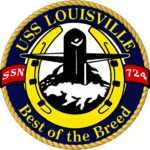USS Louisville (SSN-724)
USS Louisville (SSN-724), a Los Angeles-class submarine, is the fourth ship of the United States Navy to be named for Louisville, Kentucky. The contract to build her was awarded to the Electric Boat Division of General Dynamics Corporation in Groton, Connecticut, on 11 February 1982 and her keel was laid on 24 September 1984. She was launched on 14 December 1985—sponsored by Mrs. Betty Ann McKee (née Harris), wife of Admiral Kinnaird McKee, Director of Naval Nuclear Propulsion —and commissioned on 8 November 1986 with Captain Charles E. Ellis in command.
.jpg) The crew of USS Louisville | |
| History | |
|---|---|
| Name: | USS Louisville |
| Namesake: | The City of Louisville, Kentucky |
| Awarded: | 11 February 1982 |
| Builder: | General Dynamics Electric Boat |
| Laid down: | 24 September 1984 |
| Launched: | 14 December 1985 |
| Commissioned: | 8 November 1986 |
| Homeport: | Pearl Harbor |
| Motto: | Best of the Breed |
| Status: | Change of homeport to Bremerton, Washington Oct. 8th for decommission |
| Badge: |
 |
| General characteristics | |
| Class and type: | Los Angeles-class submarine |
| Displacement: | |
| Length: | 110.3 m (361 ft 11 in) |
| Beam: | 10 m (32 ft 10 in) |
| Draft: | 9.4 m (30 ft 10 in) |
| Propulsion: | S6G nuclear reactor |
| Speed: |
|
| Complement: | 12 officers, 150 enlisted (including 20 CPOs) |
| Sensors and processing systems: | BQQ-5 passive sonar, BQS-15 detecting and ranging sonar, WLR-8 fire control radar receiver, WLR-9 acoustic receiver for detection of active search sonar and acoustic homing torpedoes, BRD-7 radio direction finder |
| Armament: | 4 × 21 in (533 mm) bow tubes, 10 Mk48 ADCAP torpedo reloads, Tomahawk land attack missile block 3 SLCM range 1,700 nautical miles (3,100 km), Harpoon anti–surface ship missile range 70 nautical miles (130 km), minelaying Mk 67 mobile Mk 60 captor mines |
Louisville serves as a trial platform for the prototype BQQ-10 ARCI sonars, which incorporate off-the-shelf computer components, allowing easy introduction of modular upgrades.
Stations and deployments
Louisville transited the Panama Canal in January 1987 to make her home base at Naval Base Point Loma in San Diego as a part of Submarine Squadron 11.
During her stay at San Diego, Louisville conducted several WestPac deployments. During her 1988–1989 Westpac deployment, Louisville visited Korea, Japan, Thailand, the Philippines, and Guam.
In January and February 1991, as Operation Desert Storm began, Louisville carried out the first war patrol conducted by an American submarine since World War II. The patrol began with a 14,000-mile submerged, high-speed transit across the Pacific Ocean and Indian Ocean to the Red Sea. Shortly after noon on 19 January, she launched Tomahawk cruise missiles against targets in Iraq, becoming the first submarine to launch Tomahawks in combat.[1] For this war patrol, Louisville was awarded the Navy Unit Commendation.
In July 1992, Louisville became the first attack submarine to work up and deploy with a carrier battle group in the Pacific.
In 2003, Louisville participated in Operation Iraqi Freedom, launching 16 Tomahawk missiles from the Red Sea against targets in Iraq. Her deployment was extended to eight and a half months in support of the campaign. She was awarded the Navy Unit Commendation for her role in the operation.
Louisville completed an extensive overhaul in Portsmouth, NH, at the end of 2008. She returned to her homeport of Pearl Harbor in the spring of 2009 as a part of CSS-3.
Louisville had a change of homeport on 7 October 2019 to Bremerton, Washington for decommission on 22 October 2019.[2]
References
- "Gulf War: January 1991." US Navy.
- "USS Louisville Arrives in Bremerton for Inactivation". DVIDS. Retrieved 31 October 2019.
This article includes information collected from the public domain sources Dictionary of American Naval Fighting Ships and Naval Vessel Register.